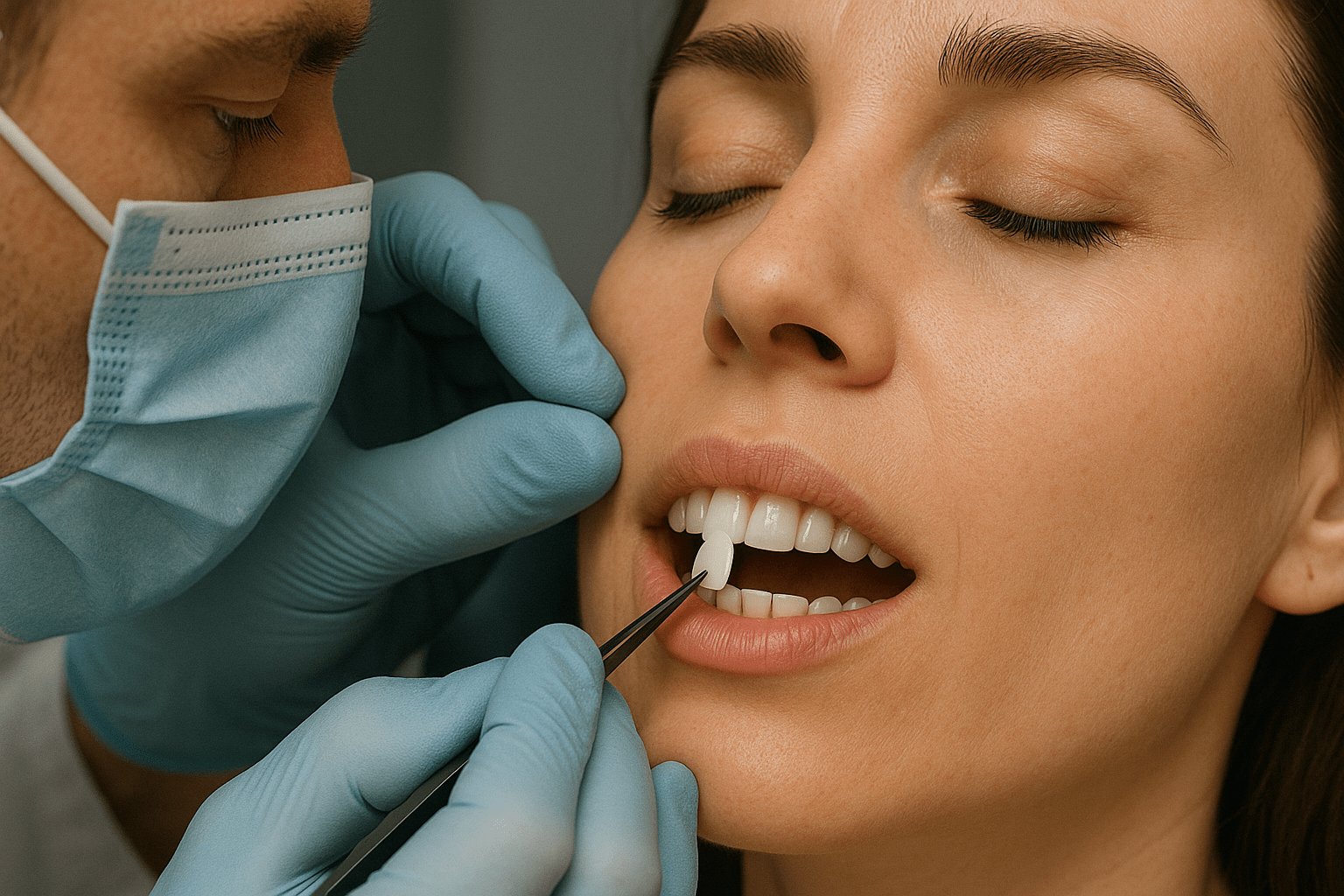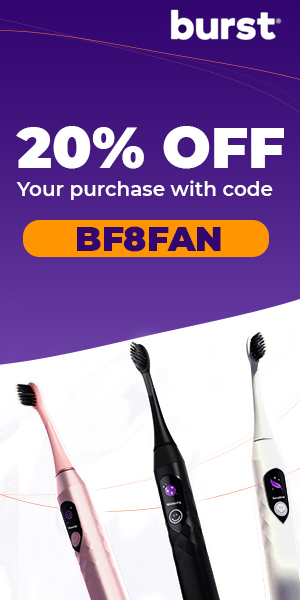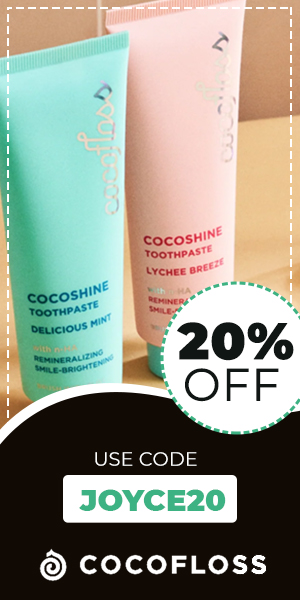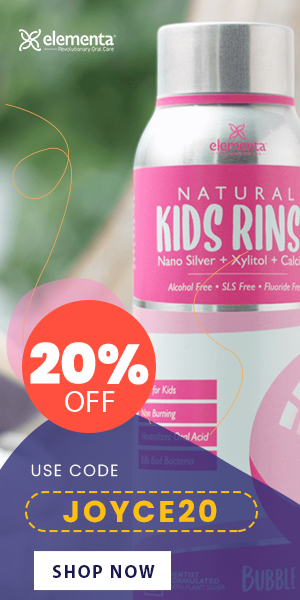Highlights:
- My four visits with design, prep + temporaries, try-in, and bonding.
- Numb throughout; mostly pressure, not pain.
- Porcelain veneers last 10–15 years.
- Brush and floss daily; gentle toothpaste; night guard if you clench.
How are veneers applied?
Veneers are typically applied over two visits. Your dentist:
- gently trims a whisper-thin layer of enamel
- takes a scan or impression
- places a temporary while a lab makes your custom porcelain shell
At the second visit, the veneer is tried in, the tooth is etched and bonded with resin cement, light-cured, then polished, and your bite is fine-tuned.
Veneers work by bonding thin, custom porcelain shells to the front of teeth after minimal enamel shaping. Most cases fit the typical timeline for getting veneers.
What are veneers & what are they made of?
Veneers are thin, custom shells that cover the front of teeth to improve color, shape, and symmetry. I use them for chips, stains that do not bleach, worn edges, small gaps, and uneven lengths.
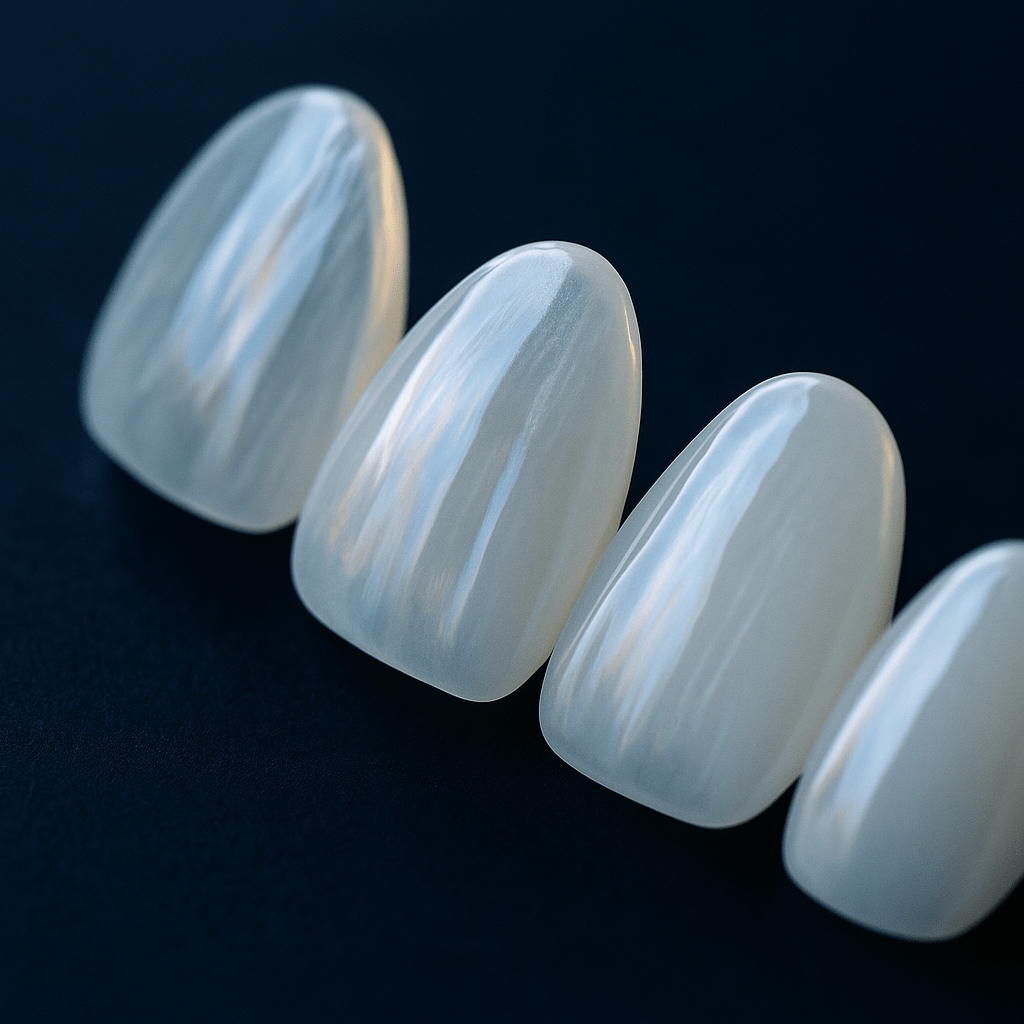
Materials at a glance
- Porcelain looks lifelike and resists stains
- Composite is sculpted chairside and is more budget-friendly (dental bonding)
I prefer porcelain for most smile makeovers because it holds color and gloss over time and blends naturally with enamel.
My 4-visit veneer process
I apply veneers in four visits. Records and design, gentle prep with custom temporaries, porcelain try-in, and precise bonding with a bite check. I make sure of minimal enamel shaping for fit and symmetry.
Step 1 — records and smile design
I take photos, scans, and X-rays to map your bite and tooth shapes.
We align goals on length, shade, and style so the lab has a clear blueprint.
- Full-face and close-up photos
- Digital scan for exact models
Step 2 — gentle prep with temporaries
You are fully numb for comfort. I reshape enamel only as needed, then place temporaries that mirror the planned design so you can test-drive the look at home.
- Smooth, minimal shaping
- Custom temporaries you can live in
Step 3 — porcelain try-in
We try in your veneers with a non-permanent paste to confirm shape, shade, and symmetry under real lighting. Nothing is bonded until you love what you see.
- Approve color and contours
- Adjust before committing
Step 4 — bonding and bite check
I treat the tooth and porcelain, seat each veneer, light-cure, then polish and refine the bite so chewing feels natural the same day.
- Precision bonding one tooth at a time
- Final polish and bite fine-tune
Does getting veneers hurt?

You’ll be numb during prep and bonding, so you shouldn’t feel pain, just vibration or pressure. Most of my patients are surprised by how comfortable the process feels.
When I’m preparing teeth for veneers, I always make sure you’re fully numb before I start. The drill may sound intimidating, but what you’ll actually notice is more of a “buzzing” vibration than pain. Think of it like getting your nails filed, just with numbing on your teeth.
After your appointment, it’s normal to experience some gum or tooth tenderness. This usually fades within a day or two. If needed, over-the-counter pain relievers like ibuprofen or acetaminophen work well to keep you comfortable.
A few things that help:
- Stick with soft foods for the first day if your teeth feel tender.
- Rinse gently with warm salt water if your gums are sore.
- Remember: sensitivity improves quickly once your veneers are bonded.
Veneers are not a painful procedure. Your dentist will always check in with you to make sure you’re comfortable every step of the way.
How do you actually bond a veneer to a tooth?
Bonding a veneer is a precise, step-by-step process done one tooth at a time. The dentist:
- Cleans and etches the tooth to create a strong surface for bonding.
- Treats the porcelain veneer with a special primer to help it adhere.
- Applies bonding resin to the tooth.
- Seats the veneer carefully into place.
- Cures with a light, which hardens the resin.
- Polishes and fine-tunes the bite so chewing feels natural.
This process makes sure the veneer is strong, blends in naturally with your other teeth, and feels comfortable when you bite and chew.
Do you keep your real teeth under veneers?
Yes, your natural teeth stay. Only a very thin layer of enamel is removed when needed for the best fit and esthetics. If you’re curious about what happens to the teeth under veneers, the key point is that the underlying tooth structure remains healthy and protected.
How long do veneers last?
With good care, porcelain veneers often last 10–15 years. Their lifespan depends on your daily habits, like brushing, flossing, and using a gentle toothpaste.
Wearing a night guard if you clench or grind, plus keeping up with regular dental cleanings, can also extend their longevity.
Recommended reading: Best Toothpaste for Veneers
How much does a full set of veneers cost?
| Type | Average Cost (Per Tooth) | Average Cost (Full Set: 6–8 Teeth) | Longevity |
|---|---|---|---|
| Porcelain Veneers | $925 – $2,500 (avg. $1,765) | $5,700 – $24,500 (avg. ~$15,500) | 10–15 years |
| Composite Veneers | $250 – $1,500 (avg. ~$800) | $1,500 – $12,000 | 5–7 years |
Costs depend on tooth count, lab quality, complexity, and location. For a personalized estimate, see my full guide to the cost of veneers.
Do’s and Don’ts for Cost Clarity
Do’s:
- Do ask for a detailed quote that breaks down per-tooth costs.
- Do compare porcelain and composite options. Composite tends to be more affordable but may not last as long.
- Do factor in any extras like preparation visits or lab fees.
Don’ts:
- Don’t assume “cheap” means safe. Stick with licensed, professional care.
- Don’t forget to ask about warranties or coverage for repairs.
- Don’t skip your follow-up cleanings. They protect your investment and keep veneers looking beautiful.
Can you eat with veneers?
Yes. Once your veneers are bonded and your bite is balanced, you can eat normally. Most people find their bite feels natural right away.
That said, there are a few smart habits to protect your investment:
- Skip using teeth as tools. Don’t open packages or bottles.
- Go easy on hard or sticky foods like ice, jawbreakers, or caramel.
- Wear a night guard if you clench or grind. This prevents chipping.
With these simple precautions, your veneers will stay strong and look great while letting you enjoy all your favorite foods.
Are veneers right for me, or should I consider alternatives?
Veneers can be a great choice if you want to fix chips, stains that don’t respond to whitening, uneven lengths, or small gaps. They’re often part of a bigger smile makeover and can completely change the look of your teeth while keeping your natural structure underneath.
Still, it’s worth knowing both sides.
Some patients worry about the downsides of veneers, like:
- the cost
- the fact that a thin layer of enamel is usually removed
- that veneers will eventually need replacement
In rare cases, people may even feel they regret getting veneers if they weren’t fully prepared for the maintenance or long-term commitment.
On the flip side, many patients share why they choose veneers in the first place:
- they look incredibly natural
- they resist staining better than natural enamel
- they can instantly create a more balanced, confident smile
In some cases, no-prep veneers or dental bonding may work instead. These options involve less enamel shaping and can be more budget-friendly, though they may not last as long as porcelain veneers.
Special cases I treat with veneers
Veneers aren’t only for making teeth whiter. They can also solve everyday issues that affect confidence and function.
Some people come in with thin teeth or edges that have worn down over time. Veneers add both length and strength, so the teeth look fuller and feel more durable.
They’re also a great option to close a gap between front teeth when the space is small, giving a straighter look without braces.
And for patients who want a full transformation, veneers often play a key role in a smile makeover. That’s where we plan the color, shape, and balance across the entire smile for the most natural result.
Can veneers be removed or replaced later?
Yes. Veneers can be safely removed and replaced when needed (cracks, leaks, or an esthetic refresh).
Replacement starts with removing veneers, cleaning away old cement, checking the tooth, and bonding a new porcelain shell. The dentist finishes by polishing and making sure the bite feels natural.
FAQs
Do veneers stain over time?
Porcelain veneers are very stain-resistant, but the cement edges and your natural teeth can still discolor. Regular cleanings and avoiding heavy coffee, tea, and smoking help keep everything bright.
Can you whiten veneers?
No, the color of porcelain veneers does not change with whitening treatments. If you want a lighter shade, the veneers themselves would need to be replaced.
Do veneers feel different from natural teeth?
Once bonded, veneers feel smooth and natural. At first, your bite may feel slightly different, but most patients adjust within a few days.
Can veneers fix crooked teeth?
Veneers can improve the appearance of mildly crooked or rotated teeth by reshaping the fronts. More significant misalignment usually needs orthodontics first.
What happens if a veneer falls off?
It’s rare, but a veneer can come loose. Save it if possible, and call your dentist right away. In many cases, it can be cleaned and re-bonded.
Do veneers require special toothpaste?
Yes. Choose a non-abrasive, gentle toothpaste. Some whitening pastes are too gritty and can dull the surface over time.
Are veneers covered by insurance?
Most insurance plans consider veneers a cosmetic treatment, so they’re usually not covered. Flexible spending accounts (FSA) or financing options can help.
Key takeaways
- Veneers are applied over two to four visits with a built-in preview via temporaries.
- Comfort is a priority; I use numbing and gentle techniques.
- Expect about 3–5 weeks from start to finish in typical cases.
- Longevity depends on home care and protection (night guard).
Follow @joycethedentist for smile tips, behind-the-scenes, and everyday dental advice you can actually use.




